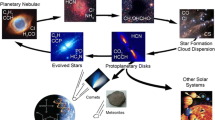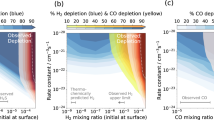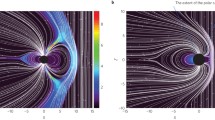Summary
In the traditional concept for the origin of life as proposed by Oparin and Haldane in the 1920s, prebiotic reactants became slowly concentrated in the primordial oceans and life evolved slowly from a series of highly protracted chemical reactions during the first billion years of Earth's history. However, chemical evolution may not have occurred continuously because planetesimals and asterioids impacted the Earth many times during the first billion years, may have sterilized the Earth, and required the process to start over. A rapid process of chemical evolution may have been required in order that life appeared at or before 3.5 billion years ago. Thus, a setting favoring rapid chemical evolution may be required. A chemical evolution hypothesis set forth by Woese in 1979 accomplished prebiotic reactions rapidly in droplets in giant atmospheric reflux columns. However, in 1985 Scherer raised a number of objections to Woese's hypothesis and concluded that it was not valid. We propose a mechanism for prebiotic chemistry in clouds that satisfies Scherer's concerns regarding the Woese hypothesis and includes advantageous droplet chemistry.
Prebiotic reactants were supplied to the atmosphere by comets, meteorites, and interplanetary dust or synthesized in the atmosphere from simple compounds using energy sources such as ultraviolet light, corona discharge, or lightning. These prebiotic monomers would have first encountered moisture in cloud drops and precipitation. We propose that rapid prebiotic chemical evolution was facilitated on the primordial Earth by cycles of condensation and evaporation of cloud drops containing clay condensation nuclei and nonvolatile monomers. For example, amino acids supplied by, or synthesized during entry of, meteorites, comets, and interplanetary dust would have been scavenged by cloud drops containing clay condensation nuclei. Polymerization would have occurred within cloud systems during cycles of condensation, freezing, melting, and evaporation of cloud drops. We suggest that polymerization reactions occurred in the atmosphere as in the Woese hypothesis, but life originated in the ocean as in the Oparin-Haldane hypothesis. The rapidity with which chemical evolution could have occurred within clouds accommodates the time constraints suggested by recent astrophysical theories.
Similar content being viewed by others
References
Arrhenius G (1987) The first 800 million years: environmental models for Earth. Earth Moon Planets 37:187–199
Barak I, Bar-Nun A (1975) The mechanism of amino acid synthesis by high temperature shock-waves. Origins Life 6: 483–506
Barry RG, Chorley RJ (1989) Atmosphere, weather and climate, ed 5. Methuen, New York
Benz W, Slattery WL, Cameron AGW (1986) The origin of the moon and the single-impact hypothesis. Icarus 66:515–535
Bunch TE, Chang S (1980) Carbonaceous chondrites—II. Carbonaceous chondrite, phyllosilicates and light element geochemistry as indicators of parent body processes and surface conditions. Geochim Cosmochim Acta 44:1543
Cameron AGW, Benz W (1980) Lunar and planetary science XX, Possible scenarios resulting from the giant impact, pp 137–138
Delsemme AH (1989) Nature and history of the organic compounds in comets, an astrophysical view. In: Comets in the post-Halley era-April, 1989. Bamberg, Federal Republic of Germany, pp 1–57
Haldane JB (1929) The origin of life. Ration Ann 148:3–10
Hartmann WK, Davis DR (1975) Satellite-sized planetesimals and lunar origin. Icarus 24:504–515
Johnson JC (1960) Physical meterology. Wiley, New York
Knupp KR, Cotton WR (1985) Convective cloud downdraft structure: an interpretive survey. Rev Geophy Space Physics, paper number 5R0327, pp 183–215
Kasting JF, Ackerman TP (1986) Climatic consequences of very high carbon dioxide levels in the Earth's early atmosphere. Science 234:1383–1385
Lahav N, Chang S (1976) The possible role of solid surface area in condensation reactions during chemical evolution: reevaluation. J Mol Evol Evol 8:357–380
Lahav N, Chang S (1982) The possible role of soluble salts in chemical evolution. J Mol Evol 19:36–46
Lazcano-Araujo A, Oro J (1981) In: Ponnamperuma C (ed) Comets and the origin of life. Reidel, Dordrecht, p 191
Lerman L (1986) Potential role of bubbles and droplets in primordial and planetary chemistry: exploration of the liquid gas interface as a reaction zone for condensation processes. Origins of life 16:201–202
Levine JS (1985) The photochemistry of atmospheres. Academic Press, Orlando FL
Maher KA, Stevenson DJ (1988) Impact frustration of the origin of life. Nature 331:612–614
Matsui T, Abe Y (1986) Evolution of an impact-induced atmosphere and magma ocean on the accreting earth. Nature 319:303–305
Mukhin LM (1989) Hypervelocity impacts of planetesimals as a source of organic molecules and of their precursors on the early Earth. Lunar Planet Sci XX:737–738
Oberbeck VR, Aggarwal (1990) Production and concentration of amino acids before 3.5 billion years ago. Origins of life (submitted)
Oberbeck VR, Fogleman G (1989) Estimates of the maximum time required for origination of life. Origins Life Evol Solar Syst 19:549–560
Oberbeck VR, Fogleman G (1990) Impact constraints on the environment for chemical evolution and continuity of life. Origins Life Evol Biosphere 20:181–195
Oberbeck VR, McKay CP, Scattergood TW, Carle GC, Valentin JR (1989) The role of cometary particle coalescence in chemical evolution. Origins Life Evol Biosphere 19:39–55
O'Keefe JD, Ahrens TJ (1982) The interaction of the Cretaceous/Tertiary extinction bolide with the atmosphere. In: Silver LT, Schultz PH (eds) Geological implications of impacts of large asteroids and comets on the Earth. US Geological Survey, Boulder CO, pp 103–120
Oparin AI (1924) Proishodenie Zhizni, Moscow: Moscoksky Robotichii. [Translation in 1967 as Appendixin Bernal JD, The origins of life. World, Cleveland]
Oro J (1961) Comets and the formation of biochemical compounds in the primitive Earth. Nature 190:389
Oro J, Miller SL, Lazcano A (1990) The origin and early evolution of life on Earth. Annu Rev Earth Planet Sci 18:317–356
Scherer S (1985) Could life have arisen in the primitive atmosphere? J Mol Evol 22:91–94
Scott J (1983) The Sciences 23:38–42
Sleep NH, Zahnle KJ, Kasting JF, Morowitz HJ (1989) Annihilation of ecosystems by large asteroid impacts on the early earth. Nature 342:139–142
Stevenson DJ (1987) Origin of the moon-the collision hypothesis. Annu Rev Earth Planet Sci 15:271–315
Stribling R, Miller SL (1987) Formaldehyde synthesis, the HCN and amino acid concentration in the primitive ocean. Origins Life Evol Biosphere 17:261–273
Woese CR (1979) A proposal concerning the origin of life on the planet Earth. J Mol Evol 13:95–101
Zhao M, Bada JL (1989) Extraterrestrial amino acids in Cretaceous/Tertiary boundary sediments at Stevns Klint, Denmark. Nature 339:463–465
Author information
Authors and Affiliations
Rights and permissions
About this article
Cite this article
Oberbeck, V.R., Marshall, J. & Shen, T. Prebiotic chemistry in clouds. J Mol Evol 32, 296–303 (1991). https://doi.org/10.1007/BF02102187
Received:
Revised:
Accepted:
Issue Date:
DOI: https://doi.org/10.1007/BF02102187




